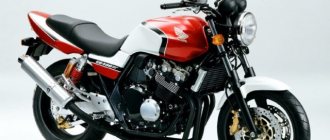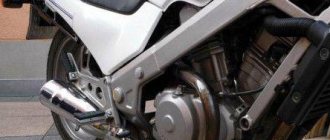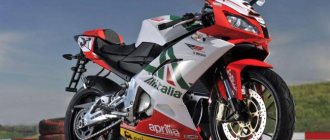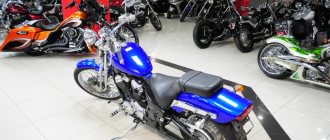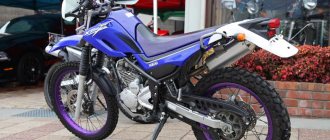In Soviet times, motorcycles of the Java 638 brand were truly the people's means of transportation. It was a mass-produced motorcycle that could be found almost everywhere: from a small village to a large metropolis.
The Java 350 in its various modifications is an economical and unpretentious motorcycle that does not require large expenses from its owner. A large number of varieties and modifications of the Java motorcycle were produced.
A model with a sidecar was provided as a family motorcycle or a motorcycle for long trips. In this way, it was possible to travel with the family or transport small loads. For example, on personal plots.
History of appearance and description of the motorcycle
The motorcycle's history dates back to 1929, when Frantisek Janicek acquired a license for the production of two-wheeled vehicles from the Wanderer company. The first motorcycles were not very popular due to their high cost, complexity of design and operation.
During the occupation of Czechoslovakia, the factory stopped producing equipment altogether and was completely transferred to the needs of the German military department. The jawa 638, familiar in the Soviet Union, began production in 1984 and had a modification of the jawa 638 5 00. This model replaced the previous machine with the index 350-633. Here the driving and performance characteristics of the motorcycle have been thoroughly improved.
The appearance of the motorcycle, although not very outstanding, is nevertheless eye-catching. Among its other brethren, it is distinguished by elements characteristic only of Java: a large headlight and turn signals protruding from it, a harmoniously located instrument panel above the headlight, a large, neatly shaped tank and a double, straight seat.
There are compartments under the seat and on both sides of the tank for storing tools or belongings. The maximum speed that the Java 350 638 motorcycle can reach according to its passport is 130 km/h, but many enthusiasts tuning the Java 638 achieved much higher figures.
The Java 638 engine is air-cooled, and this fact also left its mark on the appearance of the motorcycle. The engine is completely open, with clearly visible structural elements. The engine also operates at higher speeds than all Soviet motorcycles produced at that time.
The Java 638 gearbox leg served as a kick starter. To do this, it was necessary to press it a little into the gearbox housing and lift it up. In the Soviet Union there was only one drawback for the owners of this motorcycle - the almost complete lack of spare parts and zip kits for repairs.
The motorcycle has proven itself remarkably well in motorsports. This bike was used in both speedway and stage racing. Motorcycles with sidecars were also used for racing.
Motorcycle Java 638 Lux
There are also two main modifications of the motorcycle - Lux and Super. They have an additional designation in the name - 000. Accordingly, the Lux modification received a special shock absorber, thanks to which it was possible to ride a motorcycle with a trailer. To make driving this version as comfortable as possible, the manufacturer installed rubber inserts for the knees and a new, more comfortable seat.
The exterior has also been improved, resulting in a different control panel and muffler. The cylinders on the Java Lux are now placed vertically, which saves space on the motorcycle.
Technical and operational characteristics of jawa 350 638
Jawa 350 638 has the following technical characteristics:
- Overall dimensions - 2110x750x1070 mm.
- Seat height - 810 mm.
- Ground clearance is 130 mm.
- Wheelbase - 1335 mm.
- Weight without fuel - 156 kg.
- Engine type: 2-cylinder, 2-stroke.
- Engine capacity - 350 cubic meters. mm.
- Power - 26 hp
- Tank volume - 17 l.
- Maximum speed is 130 km/h.
The fuel consumption of the Java 350 638 motorcycle is about 6-7 liters per hundred, which is a pretty good indicator for this class of motorcycle of that time, because only Japanese motorcycles, which are much more expensive, gave similar results.
Smooth running was achieved by a 4-speed gearbox consisting of three main shafts. The steering function was a conventional Java 638 telescopic fork. The electrical circuit of the motorcycle is based on a 12V circuit. Generator Java 638 with a power of 210 W, at 14V and 15A at 5000 rpm.
The Java 638 carburetor is a float carburetor with a central chamber equipped with a device for easy engine starting. When operating a motorcycle, it is necessary to pay due attention to the Java 638 crankshaft, because due to insufficient lubrication, this is a rather vulnerable part of the motorcycle.
MY MOTORCYCLE
The most powerful, fastest and most advanced Jawa in the late 60s became the banner of the success of socialism. Alas, the fate of this extraordinary machine clearly reflected all the shortcomings of the socialist formation.
During the classic era of motorcycle racing - the 50s and 60s - Czechoslovakia was the only country behind the Iron Curtain that could withstand the pressure of the Italians and Japanese in the prestigious senior classes. Yes, of course, the two-stroke MZs created by the genius of Walter Kaaden periodically made forays into the 350 cm³ category, and in the USSR they developed a series of four-cylinder Vostoks. But only the Czech Jawa and ČZ achieved noticeable success in the 350 and 500 cm³ classes, fulfilling the main ideological task - to show that the communists are capable of much.
Jawa's most successful year was 1961, when its leading rider Franta Stastny became silver medalist in the 350cc world championship behind Gary Hocking in the MV Agusta, with his teammate Gustav Havel finishing third. From 1960 to 1965, Stastny took fourth place four times in the 350 cc class and was a constant thorn in the ass of the much richer teams MV Agusta and Honda, who also did not know all this communist nightmare with obtaining visas, obtaining foreign currency, etc. In the 352cc version, Stastny also finished fourth in the 500cc World Championship in 1965, and the following year gave Jawa its only 500cc Grand Prix victory, at the Sachsenring just a few kilometers away. from the Czech border. I can imagine what a banquet they threw in Prague back then!
Franta Stastny in a four-cylinder Jawa at the Czechoslovak Grand Prix in Brno, 1968.
All these successes were achieved on motorcycles with classic four-stroke in-line twins, with two overhead camshafts. But Jawa designer Zdenek Tichy was one of the first in Europe to understand that the future belonged to a different type of engine, and designed several two-stroke racing cars: first, single-cylinder machines with piston gas distribution for Eastern European private racers, and by 1966, air-cooled V-twins (125 , 250 and 350 cm³) with spool valve timing. The crowning achievement of his work was the Jawa 350/673 with a V-shaped “four” liquid cooling, which debuted in 1967 at the Dutch TT in Assen in the hands of Gustav Havel (Stastny was then recovering from a broken leg). But at first the car turned out to be extremely unreliable: its engine jammed three times during training and, finally, in the race itself. Alas, this was a common problem for all factories of the communist bloc: they did not have access to high-quality bearings and metals. Therefore, in extreme conditions, Jawa two-stroke engines “caught a wedge” - something that reliable four-stroke engines did not know.
The four-cylinder Jawa engine with a cylinder angle of only 35° is a fairly compact unit.
Nevertheless, the four-cylinder Jawa was at the forefront of technical thought at that time. Its layout was similar to the Yamaha V4 that dominated the 125 and 250 cc world championships in 1967-1968. But the cylinder angle - 35º - was less than that of the Yamaha, which provided a more aerodynamically advantageous profile. The engine had four separate crankshafts connected to a central spur gear sitting on an intermediate shaft. This, in turn, transmitted power to the clutch, and also drove the water pump and, later, the lubrication system pump. A unique design feature is that each of the crankshafts could be removed without removing the engine from the frame. Separate castings formed the outer half of the crankshaft chamber and the housing for the spool, so replacing the crankshaft took only 20 minutes. The steel connecting rods had roller bearings with cages in the upper and lower heads, and the forged pistons each had one chrome-plated compression ring.
A unique feature of the engine is four separate crankshafts connected to the transmission via an intermediate shaft.
The 345 cc engine (48 × 47.6 mm) was initially equipped with thermosyphon-type liquid cooling, but in 1968 a water pump was introduced into its design. At the inlet there were disc valves and Amal GP carburetors with diffusers with a diameter of 27 mm (25 mm on short routes). Cast iron liners with three bypass and one exhaust port were inserted into the light alloy cylinders. This engine produced 68 hp. at 13,200 rpm. This power was transferred through a large dry clutch to a seven-speed cassette-type transmission, in which the shafts could be removed to change ratios without disassembling the engine - a great innovation for the time.
Despite the four-cylinder engine and side-facing carburetors, the Jawa 350 turned out to be quite narrow.
This unit, cutting-edge for the 1960s, was integrated as a load-bearing element into a duplex steel tubular frame. At the front there was a telescopic fork of our own production, at the rear there was a suspension with a pendulum made of oval pipes and two Girling shock absorbers. Drum brakes - four-cam at the front and two-cam at the rear - stopped this rather heavy device for its class (138 kg - despite the fact that the 250 cc Yamaha RD05 weighed 118 kg, and the 350 cc MV Agusta - 128 kg).
The steel duplex frame is closed at the bottom through the power unit.
After a disappointing debut in Assen, the Czechs decided to skip the next round, in the GDR, in order to better prepare for their home race in Brno. There Havel finished in an encouraging fourth place, behind Hailwood in a six-cylinder Honda and a pair of MZs. After this, Tichy and his team did not enter the car for the 1967 races, focusing on fine-tuning its reliability and speed. But the beginning of 1968 still turned out to be a disaster: the engine kept jamming, the bearings were destroyed, and the pistons were seized. Only by the middle of the season did things improve. At the home race in Brno, Stastny climbed to the podium - he became third, behind Agostini in an MV Agusta and one MZ. Then there was fourth place in Ulster and sixth in Monza - and in Italy, which is a shame, he was ahead of the ČZ driver.
Amal GP carburetors are equipped with float chambers with separate installation. The clutch is dry type.
Therefore, for the 1969 season, Tichy developed an improved version of the 350/673A - with a new, lower frame, Czech-developed electronic ignition and an under-seat oil tank that supplied oil to the main and connecting rod bearings in addition to the 4% additive in gasoline. Over the winter, Stastny traveled 260 km along the runways of Prague Airport, so there was hope that the car would be reliable. Or maybe he will become a contender for victory - with the team's new superstar, Englishman Bill Ivey. A former 125cc world champion, Ivey, at 157cm tall and weighing under 50kg, was the ideal racing jockey. In 1968, he became the silver medalist at the World Championships in two classes - 125 and 250 cm³, following his Yamaha teammate Phil Reed. But in the 1969 season, the Japanese decided to leave road racing, and Bill switched to auto racing, buying a used Brabham BT23C Formula 2. Participating in such competitions at your own expense is a ruinous undertaking, and to finance them, Ivey wanted to find a paid place in the factory motorcycle team. for a year.
Bill Ivey
Bill celebrated the New Year in Switzerland, with his friend and racing rival Luigi Taveri. Among the guests was Franta Stastny, who described to him the advantages of the modernized Jawa. So Stastny went home with a letter from Ivy, in which he offered his own. Bill reported that his fee in 1968 was $28,000 ($200,000 in today's money), but for Jawa he was willing to go for $20,000.
Bill Ivey and the four-cylinder Jawa.
And here began the typical games with currency for the communist bloc. When Ivey arrived in Czechoslovakia on January 31 to get acquainted with the car and sign a contract, he was offered to take the fee partly in motorcycles - serial single-cylinder racing machines. Bill could only agree...
On March 5, Ivey tested the car for the first time at the Brands Hutch track - and immediately improved the lap record in its class by one second. But the debut in the race was not so encouraging. On April 13, the Jawa team took part in the pre-season Temporada di Primavera in Italy, and on a twisty track where they had to use the first gears intensively, Ivey and Stastny retired due to jammed engines. The first performance in the Grand Prix was not the best: Bill was third and was hot on the heels of Carruthers, who was in second, but retired again due to engine failure.
The bike prepared for Bill Ivey is easily identified by its single-cam rear brake.
But a week later, at the German Grand Prix in Hockenheim, Jawa showed its potential. This fast track was perfect for her high-revving engine, and although the race was won by Agostini in the MV Agusta, the next two places were taken by Ivey and Stastny. Moreover, Ivy ran out of gas at the finish line: the Czechs were unable to correctly calculate the capacity of the gas tank simply because until that moment the motorcycle had never completed a full race.
The next stage also took place on a high-speed track, in Assen, Holland. Ivey qualified second behind Agostini, overtook him in the first laps, but then the Jawa suffered one cylinder failure and the Briton lost the lead. But when the engine finally gave up, Bill closed the 100-meter gap and took the lead again on the 12th lap! It seemed that victory was in his pocket, but the engine began to stall again, and Ivey let Agostini take the lead, but still came in second.
Bill Ivey in a Jawa battles for the championship with Giacomo Agostini in the MV Agusta, Assen, 1969.
The next stage of the World Championship took place at the Sachsenring track in the GDR. But the day before, during qualifying in the pouring rain, Bill Ivey crashed on the finish line - so much so that his helmet flew off to the other side of the track. He died in hospital from a head injury. He was only 26 years old.
Disassembling the engine showed that the bearing of the lower left cylinder was jammed. And Bill, according to eyewitnesses, was just unfastening his helmet, preparing to enter the pits, and therefore did not have time to squeeze the clutch lever. His death put an end to plans to compete in the 500 cc class - Ivey had already tested the bored-out “four”, and with very encouraging results. And the Italians from MV Agusta slowed down the development of a six-cylinder engine - Agostini insisted on its creation, fearing Czech competition.
As a sign of mourning, Stastny did not start in the GDR. And a week later, at his home track in Brno, Jawa invited Australian Jack Findlay to be his partner. Alas, on the first lap of qualifying, the legionnaire fell and broke his collarbone, so his car went to the Italian Silvio Grassetti. He finished in an encouraging third place, behind Agostini and Rod Gould on the Yamaha.
At the GP of Italy, Jawa entered three vehicles at once: for Stastny, Findlay and Grassetti. That year the race took place not at Monza, but at Imola - so the offended Count Agusta withdrew his team (Monza was located almost outside the gates of his factory). And the prospect of a clear victory loomed before Jawa... Alas, Findlay fell again at the beginning of the race and ended up in the hospital, Stastny drove into the pits and never returned to the track. But the Italian, although he did not start very well, soon took the lead and led almost the entire race. But already two laps before the finish, he began to greet his fans, forgetting that removing his hand from the clutch release lever on a Jawa is fraught with danger... Fortunately, the engine did not jam, but Grassetti, carried away, drove off the track. While he was getting out onto the asphalt, Phil Reed on a Yamaha took the lead. What bad luck!
Grassetti was rehabilitated for his stupid mistake at the next stage, in Yugoslavia. In the absence of the MV Agusta drivers, he both won qualifying and dominated the race from start to finish, giving the four-cylinder Jawa its first victory. Stastny finished third. The points won behind the wheel of Jawa, coupled with those scored at the beginning of the season on Yamaha, allowed Silvio to take second place in the championship. Stastny was ninth, Ivey was tenth, posthumously.
Grassetti signed a contract with Jawa for the next season, but it was not so inspiring. Silvio took a couple of third places in the pre-season races, missed the first stage of the championship, and finished third in the GP of Yugoslavia. For the Czech round, Jawa provided a V4 to New Zealander Ginger Molloy; he retired on the eighth lap with a jammed engine and refused to further compete for the brand: “This car is certainly capable of beating Agostini and his MV Agusta,” he said after the race. “But don’t expect me to smash myself into pieces to prove it.” And Grassetti performed worse and worse - he was able to earn points in only one race in the second half of the season, finishing fifth in Monza, a minute behind Agostini. After this, Jawa decided to refuse to participate in road racing, giving priority to those competitions where it was ahead of everyone - track racing and the “six-day race”.
The fate of the artifact.
After the completion of the Jawa racing program, one of the four-cylinder motorcycles was bought by its designer, Zdenek Tichy. And already in the 90s, it was acquired by Jean-François Baldet, a motorcycle racing star of the early 80s, who successfully competed for the Kawasaki factory team (one second and four third places in the 250 and 350 cm³ world championships). “I first went to the race track in 1973,” Balde told me, “so I didn’t compete directly with Jawa. But I had a clear idea of what kind of machine it was: a fantastically avant-garde device, created against all odds by people in love with motorcycles who worked at a state-owned enterprise behind the Iron Curtain, so that many things common in the West were inaccessible to them. Therefore, when I went to races in the Eastern Bloc countries, I always took a large supply of tires, oils and spark plugs with me - and, when leaving, I gave them to the local racers. Unlike some of my colleagues, I never profited from such help - and, apparently, that’s why fate rewarded me: one day one of the athletes who used my services put me in touch with a man who sold Bill Ivey’s Jawa. It’s quite easy to recognize just such a device: four-cylinder Jawas usually used a two-cam rear brake, but Ivey insisted on a single-cam one - and the car was converted to it.”
Jean-François Baldet is the man who brought the unique Jawa to life.
Balde took the motorcycle to France and began its restoration, which, due to his meticulousness, took ten years: “I wanted to restore the car to one hundred percent original condition - right down to the handlebars and Dunlop triangular tires, for which I developed a special rejuvenation technology. I even found a Smith speedometer made specifically for this device - it is marked up to 15,000 rpm, but the motorcycle I bought had a regular one, with a scale up to 12,000 rpm. The first time I started the engine was in 2002 - and it was still like making love for the first time! After the restoration was completed, I spent about five years participating in various events, from classic motorcycle races to the Louis Wootton competition - which, by the way, I won! The most interesting thing is that during all this time I did not have any problems that plagued the factory team - I only had to replace a couple of spark plugs. I believe that it’s all about modern fuels and oils, which are of much better quality than in that era. In addition, I modified the ignition to make it more reliable.”
But then it was time to part ways: “I’m not a collector,” Balde explained. “And, having played enough, I decided to do something else.” And then Bernard Richards, the head of the luxury watch company BRM, turned up. He wanted to put something in his office that would make him smile every day when he came to work. So he bought a Jawa and is smiling!” Only a few years, though - in 2013, Sammy Miller bought the motorcycle for his magnificent museum. And since Sammy believes his exhibits should be driven, I had the chance to test this car on the track.
And here's the first surprise: the car is unexpectedly spacious. Of course, not to the same extent as the AJS 7R or Norton Manx, but it’s quite comfortable for me - even though I’m 20 cm taller than Bill Ivey. The startup procedure is a little complicated, but understandable. Turn the gas tap, then fill the float chambers and enrich the mixture by pulling out the button on the left handlebar. Press the ignition switch at the steering column and start the engine in second gear. Warm up the engine thoroughly until the temperature gauge needle is in the middle of the green sector. Now the engine will start confidently with a rolling start.
The four-cylinder Jawa now resides in the Sammy Miller Museum (pictured right), a unique collection of over 400 motorcycles (www.sammymiller.co.uk).
Gear changes are quite heavy and slow, but at least they are precise. But the massive dry clutch works great: the squeeze is light and the actuation moment is clearly noticeable. And this is important: below 8000 rpm there is no traction, and in slow corners you have to play along with the clutch to keep the engine in the operating range. And don’t even think about shifting up until the engine reaches 12,500 rpm - you won’t have to go back. However, this characteristic is typical for two-stroke engines with disc valves at the inlet. At least the power delivery was quite controllable - better than other two-strokes of the era.
Inspires confidence and controllability. The triangular-section tires provide a smaller contact patch on a straight line and a larger contact patch when cornering, so the Jawa changes line quickly without feeling nervous. The brakes also work well, although the rear one is set more for formality - and why did Ivey prefer a single-cam? But the front four-cam does its job well - at least by the standards of the time.
The Jawa V4 has a bad reputation as "The Motorcycle That Killed Bill Ivey". But, as the racing practice of Jean-François Baldet has shown, it is quite reliable with modern fuels and oils. It is a pity that Czechoslovakia gained access to advanced materials and technologies only after Perestroika. Otherwise, Ivy would definitely have taken the championship from Agostini.
Release:
MOTO Magazine – April 2016
Author:
Alan CATCHART, translation by Alexander VORONTSOV, photo by Kiyoshi NAKAMURA and from the author’s archive
Refinement and tuning
Since the new Java 638 is very popular and the demand for this motorcycle does not subside, craftsmen continue to refine both the appearance of the motorcycle and its characteristics. On the Internet you can find many reviews and interesting technical solutions for tuning this motorcycle.
The change in appearance is sometimes so dramatic that it is difficult to believe that this motorcycle was once a classic java. The wheel rims are replaced with cast light alloy ones, the old front steering wheel fork is replaced with a more advanced, longer one, the seats and headlight are changed. There are simply no limits to the imagination of inventors.
To improve driving characteristics, drum brakes are replaced with higher quality disc brakes. To increase the service life of the engine, the bearing seats are changed, thereby improving their lubrication.
Previous post Java 350 – parameters and special properties of the legend
Next entry Technical characteristics of the Planet Izh 4 motorcycle
Motorcycle appearance
The Java 350 looks simple, it has a large headlight at the front, turn signals on the sides, and the dashboard looks very harmonious.
The wheels are spoked, so when the bike was driven in sunny weather it looked very impressive. The motorcycle has a fairly large tank, but neatly shaped. There are pads for the driver's knees. The brand name “Jawa” looks beautiful on the tank.
The Java 350 638 model has a flat 2-seater seat, which is divided by a belt for the passenger to hold on to. There are glove compartments under the seat and under the tank. Externally, the Java 350 looked really stylish, which was lacking in motorcycles like IZH Jupiter 3.
You may also be interested in: Inexpensive Irbis motorcycles: only for beginners?
Price Java 350-638
This motorcycle has not been produced for a long time, but there are still many people who want to buy such a device, so the price for it remains quite high. Moreover, it can be very difficult to find such an old motorcycle in good condition. But nevertheless, you can find interesting options, the price varies and depends on the condition, usually from 25,000 rubles to 250,000. Such is the range of prices.
It will also be interesting: Features of the all-wheel drive Ural motorcycle: an off-road “thunderstorm”
And then driving the Java 350:


